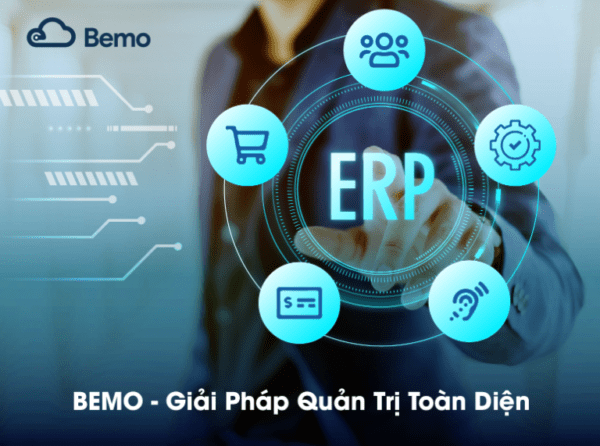What is ERP? How to solve business problems by ERP?
Nowadays, besides technology applications that help businesses solve many management problems, the digital transformation process has also become an important competitive advantage. A typical example is the ERP system – Enterprise Resources Planning, a recognized solution that brings to long-term economic benefits. But at present, in Vietnam, there are many medium and large enterprises that have not yet approached and understood the core value of this system.
The following article will lay the starting foundation for you, who are wishing to learn and implement an ERP system to improve business administration efficiency.
Table of Content
1. What does ERP mean?

Despite the vast amount of information on the forums, you just need to remember that ERP is enterprise resource planning software, which stands for Enterprise, Resources, and Planning.
First, we’ll explain the resource (R) factor. This is a word that represents a core resource, especially in the field of information technology, it refers to the software, hardware, or data used on a system.
In the ERP system, the enterprises must have the ability to convert human resources into resources, and the departments that are the focal point of exploitation will update the status of the resources.
The reason resource (R) is mentioned first is to emphasize that the success of ERP implementation depends on this factor. Enterprises must find a team of capable consultants, combined with a strict working process while implementing the system. It can be said that this stage will begin to standardize the data, as well as the most expensive to convert human resources into resources (R).
Next, we will analyze the planning factor (P) to know how the enterprises plan when implementing the ERP system?
The predictive and computational capabilities of the ERP system will help businesses anticipate arising in the operational stages. In addition, businesses can also plan pricing, discounting and purchasing policies that will help minimize errors in actual business.
The planning (P) of ERP also supports enterprises to make necessary management and after-sales plans in business such as human resource management, sales management, effective customer care, …
After having sustainable resources and a smooth operation plan, the letter (E) – Enterprise represents the essential connection between departments. This means that all business activities are optimized on a single system, and managers can check and analyze the performance of each department easily.
The overall management difficulties of the enterprise can be completely solved on the same ERP platform.
For example, when there is no ERP system, in the recruitment stage, candidates have to go through a process of filling out forms, the human resources department processes information and enters data on the system, which consumes a lot of time.
Furthermore, after the interview process, the specialist department will have to decide whether to select the candidate or not. If so, other departments must participate in the preparations to welcome the new employee, and the equipment management department also needs to plan the allocation of computers and a series of accompanying documents for asset management.
This process makes it difficult when departments have to perform tasks on separate systems, because each stakeholder will not be able to know what stage the work is going on and there is no timely solution when a problem happened.
Thus, ERP was born to solve comprehensive management problems to help optimize processes and connect departments more closely.
2. What are the modules most used in ERP systems?

The outstanding benefits of ERP are standardizing processes and connecting departments, helping to solve the management problem thoroughly. It can be said that ERP is an all-in-one system consisting of modules. Here are 5 typical modules that BEMO focuses on when deploying to target medium and large enterprises:
- Human resource management solution
- Sales management solution
- Customer care solutions
- Asset management solutions
- Management and assignment solutions
So what management problem will each module solve?
- Human resources management:
As the size of the enterprise grows, the human resource management process requires more closely. This module will help businesses automate all processes from recruitment, timekeeping, reward, to measuring the performance of each employee. Based on that, businesses can plan to use resources appropriately.
- Sales Management:
The challenges in sales management are fully optimized when businesses can integrate software for sales, purchasing, inventory control, connecting the delivery system, or peripherals applications on the same system. In addition, businesses can handle sales problems quickly such as checking the shipping process or the amount of inventory on this module.
- Customer Relationship Management:
The ERP system not only stops at the sales stage, but the solution also helps to optimally connect the customer’s transaction life cycle through the customer care module (CRM). At this stage, the system will record quick responses and assist the sales team to easily increase sales.
In particular, the reports on the system are a measure for businesses to see their business situation and respond to the brand in the most intuitive way to make timely adjustments.
- Asset Management:
When the business grows in size, the control of assets such as purchasing, allocating, circulating… will face difficulties if there is no system to link departments.
Setting up ERP is a smart way to optimize costs when businesses can check the work assignment of each employee, the number of assets in each department, helping to reduce the risk of waste and loss.
The system even shows which assets are about to expire or need maintenance so that the department can quickly handle them.
- Manage and assign tasks:
This module helps managers divide and create a list of tasks to be done, as well as track the completion of employees’ work. Each task can be assigned to one or more people.
During the working process, the system will automatically update the completion progress so that the manager can easily monitor and make timely changes.
When business approach digital transformation, ERP provides the foundation to share and connect the information across departments that keeps employees working in sync to better manage.
You can learn more Why is ERP considered unsuitable for your business?
3. The advantages of ERP system for small and medium-sized businesses
We can not deny that the digital age has opened up a new management method to help businesses operate more smoothly and professionally. In particular, ERP is an indispensable part when medium and large enterprises are looking to grow exponentially.
The consequences we can see when analyzing the core values of implementing the ERP system and the above management modules are:
- Internal connection efficiently supports the working process instead of each department operating on a separate software, making it difficult for businesses to make quick decisions.
- The managers can check details of activities and work information on the same interface providing a variety of reports.
- Based on the needs of each department, businesses can customize and synchronize the process.
- Each department can measure the performance of each employee on the system in detail.
In short, the ERP system provides a comprehensive solution for businesses, helping to manage more closely, increase productivity and business efficiency. Continue to follow us for more useful updates.














